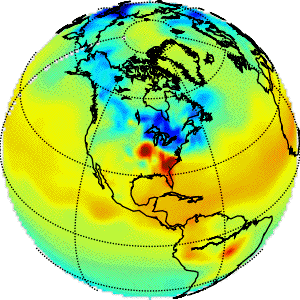Thursday Topsight, March 22, 2007
 • Mapping the Present, Seeing the Future: Wired's Danger Room blog noted late last month the emergence of a fun little mashup map site called GlobalIncidentMap.com. Global Incident Map smooshes data about a wide array of suspicious events onto a Google Map page. It's not the first or the only site to do this, but it does so in a way that nicely maximizes visitor anxiety.
• Mapping the Present, Seeing the Future: Wired's Danger Room blog noted late last month the emergence of a fun little mashup map site called GlobalIncidentMap.com. Global Incident Map smooshes data about a wide array of suspicious events onto a Google Map page. It's not the first or the only site to do this, but it does so in a way that nicely maximizes visitor anxiety.
But I thought of it again when I saw this pair of reports: the US National Oceanic and Atmospheric Administration has opened up its CarbonTracker website, offering high-quality maps and animations of carbon dioxide levels for both North America and the globe; and the European Space Agency has now released its SCIAMACHY maps and data, showing the global flux of both atmospheric CO2 and methane. In neither case is the mapping real-time (the ESA data goes through 2005, while the NOAA maps go through 2006), but that will change.
My question, though: Why can't we have a Global Incident Map type site for the environment? Combing through news reports, NASA/ESA/NOAA data, even user submissions to put together an anxiety-inducing map of where the world is going environmentally. It should be possible...
• Wargaming Pandemic: Set aside the images of a 1980s teen-action movie or generals with plastic tanks -- wargames are one of our best tools for figuring out adaptive responses to complex problems. A wargame is, at its core, an interactive simulation of a high-cost, high-uncertainty environment. While that environment is, historically, usually a battlefield, it doesn't have to be. Case in point: the wargame played in Washington last week, bringing together undersecretaries and health agency directors from Cambodia, China, Vietnam, Laos, Myanmar and Thailand, along with people from the UN and WHO. The topic? H5N1 flu.
Participating nations also sent officials from their ministries of foreign affairs, agriculture, tourism and internal security, as well... Their participation was essential, [Terrence Taylor, director of biological programs at the Washington-based Nuclear Threat Initiative] said, because the kind of influenza pandemic envisaged by the exercise scenario, with millions infected and survival rates low, would be much more than just a health crisis."If you're going to deal with this properly, you have to address questions of population movement, border controls, of how to quarantine a population that feels threatened," he said.[...]
Using techniques similar to those in modern war-gaming, the tabletop exercise envisaged a three-stage pandemic influenza emergency unfolding over a six month period after the mutation of the deadly bird flu virus H5N1 enabled it to be transmitted easily between humans.
Unlike a policy paper or a conference, a wargame requires the participants to make decisions predicated on the consequences of earlier choices. It's not just "if-then," it's "if-then-then-then-then..."
Wargames have fairly broad strategic application. In experience, they can be useful follow-ons to scenario exercises, giving strategists and planners an opportunity to test out competing approaches in the context of a changing environment.
• Please, Not A Twitter Entry: Before SXSW, I'd never heard of Twitter, a "microblogging" app that lets you send quick updates via text message (IM or SMS) to people who care about the very latest cute thing your cat did. After SXSW, I'd be happy never to hear the word again. The program went through an entire invisible except to people in the know -->fringetech that wows the geekerati -->what do you mean you don't use it? -->ubi-"we're thinking of calling it twitter-by-south-twitter next year"-quitous -->"twitter? that's so over" cycle in 4 days.
Still, this is kind of cool: near-real-time earthquake alerts via twitter. Just add sfearthquakes as a friend.
• Can't Wait for this Book: Design guru Don Norman -- author of the iconic Design of Everyday Things, among others -- is working on his next guide: The Design of Future Things. Due out in November of this year (maybe), DoFT is Norman's attempt to sketch out design rules for the era when the stuff around us is smarter than we are.
The first chapter and the afterward are now available in draft PDF form.





